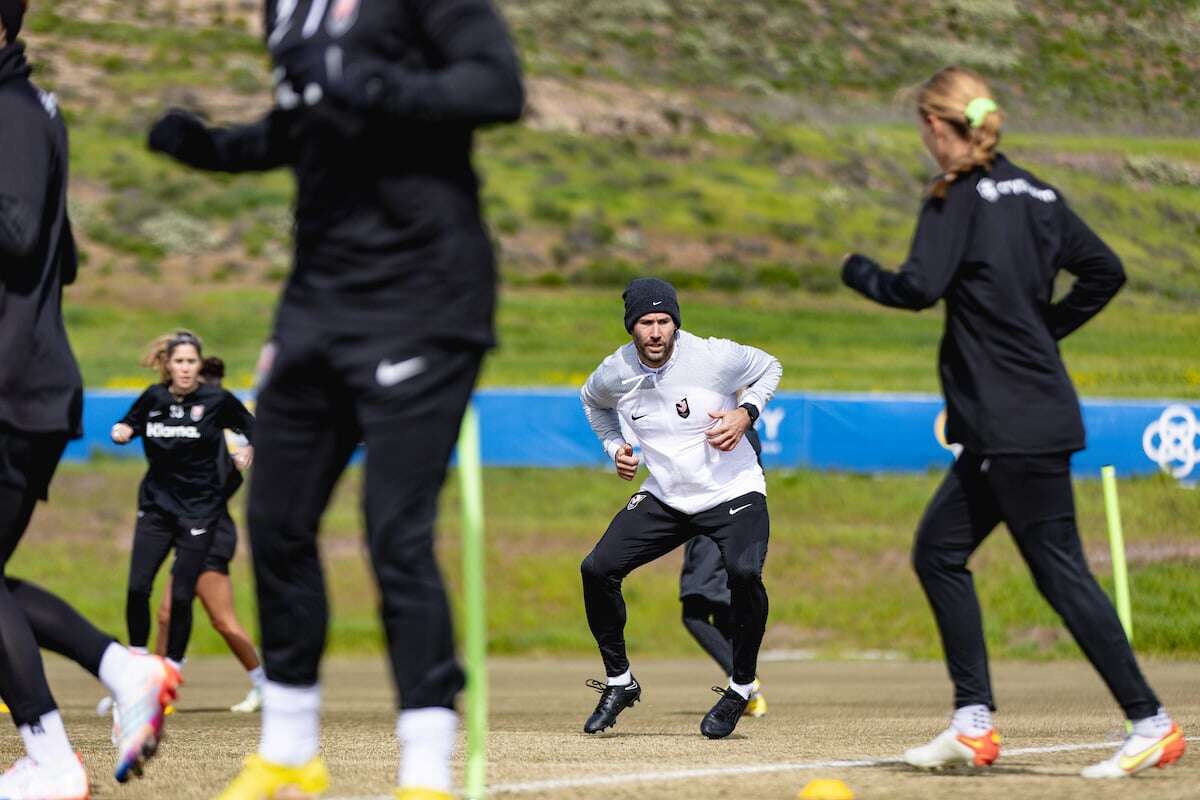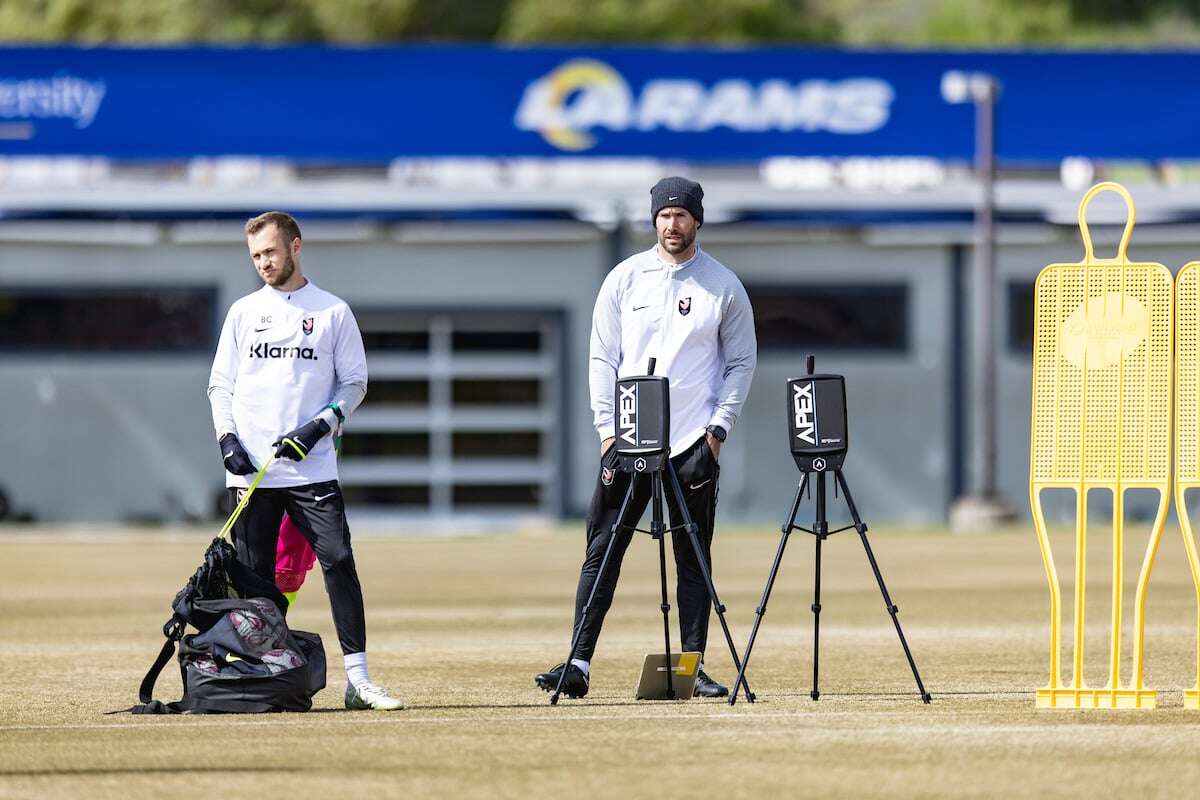

Angel City's technical staff has a lot to accomplish in the eight weeks between the beginning of preseason training and the season opener. The team has to know their teammates and how they play; they have to understand the coaching staff's tactical principles; and they have to actually practice putting all that together.
In order to execute any of it, though, the team needs a high level of physical fitness, and that's where Dan Jones, Angel City's head of sports science, comes in.
'What entails at this moment in time,' says Jones, 'is the physical preparation and the planning on the physical side to get the athletes ready to compete at a high level.'
That physical preparation has several different components. At the most basic level, it means increasing players' fitness gradually and keeping them healthy.
Every player reports for preseason in a different place fitness-wise. 'Some athletes, at the end of the season,' Jones explains, 'might take a couple of days off and immediately begin training with their own personal trainers and conditioning coach or technical coach.'
Other players, especially those who had a particularly exhausting season, take a more extended break. When they do get back into regular training, some players put a lot of time and effort into strength and conditioning, while others 'might rely on a natural state of fitness that they kind of live in and not do a ton of fitness during the offseason,' says Jones.
To account for those differences, the first order of business for Jones and the rest of the high performance team—which also includes the medical staff—is assessing each athlete's starting point. Based on that starting point, as well as their baseline aerobic fitness level, the demands of their position, and any imbalances or weaknesses they might have, each player gets a personalized training plan.
To accomplish those plans, at training, 'we will sort players into different buckets,' says Jones. 'So the more fit players might be doing additional runs during preseason on specific days at X speed, and then another group might be doing a similar run, but in a shorter time frame to achieve a different result—all working towards that same goal of being 90 minutes fit.'
Players are also grouped according to the demands of their specific positions.
'Center backs in general,' for example, 'need to be able to be extremely physical, extremely agile in terms of opening up and turning their body. They need to be incredibly strong as well, and ideally they have good jumping ability,' Jones says. However, they rarely need to run long distances quickly.
That contrasts with what, say, the outside backs need: 'We need to make sure that they can do what we call repeat high intensity bursts,' he says. Because they typically spend the game running up and down the wings to contribute on both offense and defense, 'they need to be able to sprint a really long distance, rest for a few seconds, and then make that sprint back, and do that run consistently with minimal rest.'
Jones's plan also needs to support the team's specific tactical style. 'That last bit is, how do we want to play and how do we want to prepare them to play?' he says. 'Most of that is accomplished through drill selection and how the coaches train and how they periodize things out,' rather than in the gym.
'If we want to be a really high-pressing team,' he continues, 'then we need to have the right positions fully capable of doing the right actions again and again. We need to be sure we're actually training in that way on the field throughout the week, so they are both getting the tactical stimulus they need and the physical stimulus.'
Finally, the high performance team is involved in designing the team's schedule, both for the season as a whole and on a week-by-week basis. Identifying rest days is part of that; they also advise the coaching staff, for example, on what training volume and intensity should look like each day leading up to a match.
As training gets underway, Jones monitors the team's on-field workload via the GPS unit each player wears. 'As we're executing all these drills,' he explains, 'I am keeping the coaches updated on whether we are hitting our targets, or if we need to do additional durations on certain drills, or do additional fitness post-training.'

The team's trip to Florida, which they just returned from, put all that to the test. In addition to training in a hot, humid environment—something they'll have to do multiple times as they travel throughout the season—they scrimmaged with an Inter Miami academy team, giving them a taste of what an away game week might look like.
Unsurprisingly, the high performance staff has a detailed script to follow when the team travels.
As soon as they arrived in Florida, the players started rehydrating. Then, 'once we landed, we immediately got into a mobility session, got their heart rate up, got a little blood flowing.'
Training the next day was light; the day after flying, some athletes will still be dehydrated, and the group had to adjust to the new environment and time zone. 'We get their heart rate up, get them to flush their legs,' Jones says, 'but not over-exhaust them, because you are at a greater risk of injury after long travel days.'
The day after that, which was match day minus three, is the most challenging physically, involving bigger spaces within the session, as well as a demanding gym session.
Finally, on the final two days before the game, sessions taper down in intensity, ensuring everyone has plenty of recovery time, in addition to continuing to eat and hydrate well. Players also get a mental break during that time, where they're not required to be with the team. The last 24 hours before a match is more focused on tactics than physical training.
With the team back in LA, the focus turns to the season opener on March 26. The team needs to be ready to play 90 minutes by then, but Jones says there's a balance between being fit enough and risking excessive injuries.
'Going into that first match,' he says, 'we're still training explosively and fast, but we want to be really fresh. A mistake a lot of teams make is they try and get too fit too fast, and they want to be in the best shape prior to that first game, which can lead to excessive injuries due to being too aggressive on the front end.'
Instead, the goal is for the group to continue building fitness as the season continues. 'We need to accomplish a 90-minute game from day one, but we want to continue that progression and continue to get fitter beyond the first game.'





